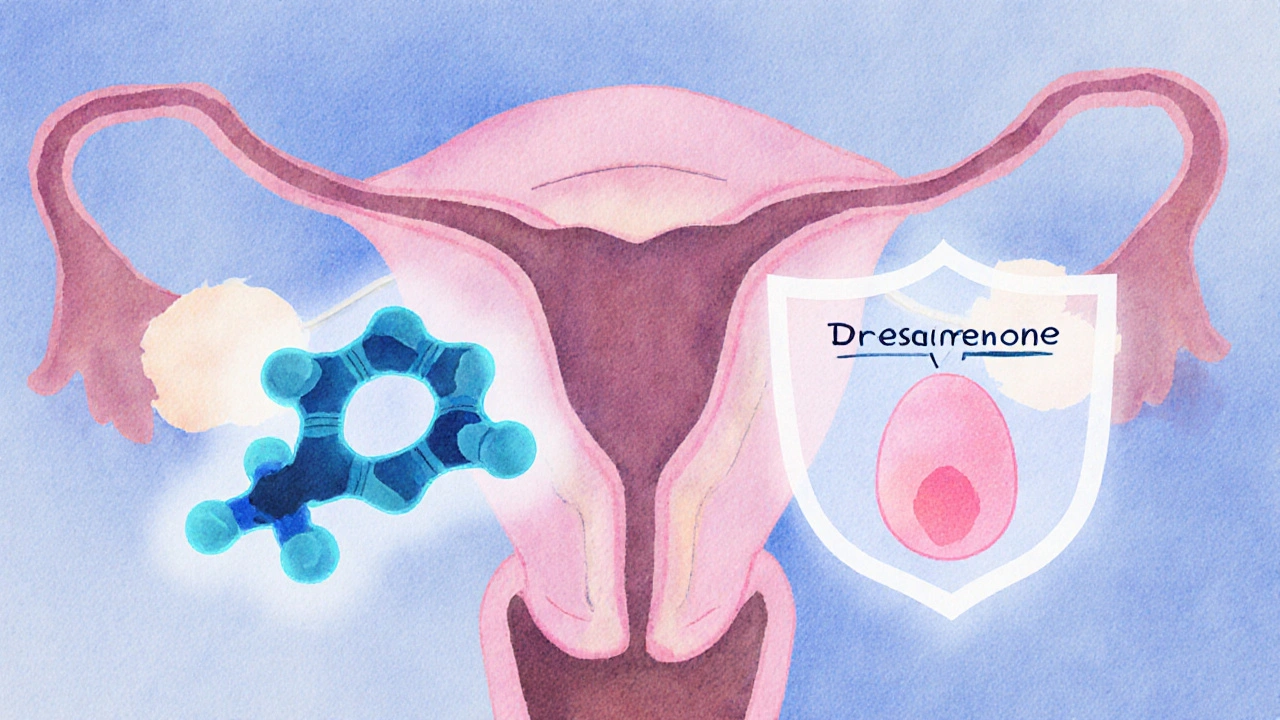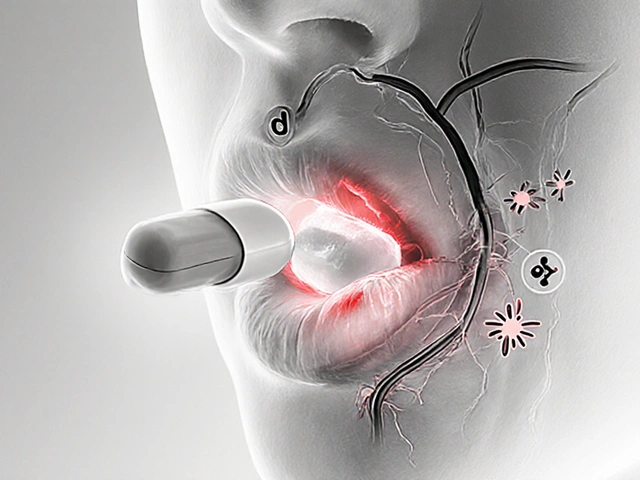Birth Control Pill Comparison Tool
This tool helps you compare your priorities and health factors to determine which birth control pill might be most suitable for your needs. Based on information from the article, select your key priorities below. The results will show which pill is most recommended for your situation.
When you’re hunting for the right oral contraceptive, the sea of options can get overwhelming. Yasmin birth control is a popular choice because it combines ethinyl estradiol with drospirenone, but many women wonder how it stacks up against other pills on the market. This guide breaks down Yasmin’s key features, compares it with five common alternatives, and gives you a clear checklist to decide what fits your health profile and lifestyle.
Key Takeaways
- Yasmin pairs a low dose of ethinyl estradiol (20µg) with drospirenone, a progestin that mimics natural progesterone and has anti‑androgen properties.
- Alternative pills differ mainly in hormone dose, progestin type, and cycle‑length flexibility.
- Women with a history of blood clots, uncontrolled hypertension, or smoking over age 35 should avoid high‑estrogen pills like Yasmin.
- Non‑pill options (IUD, implant, patch) provide comparable efficacy with fewer daily compliance demands.
- Use the decision checklist at the end to match your priorities - whether that’s acne control, cycle regularity, minimal side‑effects, or cost.
What Is Yasmin?
Yasmin is a combined oral contraceptive that contains ethinyl estradiol and drospirenone. Approved in the United States in 2001, it is marketed for pregnancy prevention, acne improvement, and menstrual‑related symptoms such as heavy bleeding.
The Core Hormones
Ethinyl estradiol is a synthetic estrogen used in most combined pills. In Yasmin it’s delivered at 20µg per tablet - a low‑dose level aimed at reducing estrogen‑related side effects while maintaining contraceptive efficacy.
Drospirenone is a newer generation progestin derived from spironolactone. It binds to progesterone receptors, provides strong ovulation suppression, and has mild anti‑androgen and anti‑mineralocorticoid activity, which can help with acne and water retention.

How Yasmin Works
The estrogen component stabilizes the uterine lining, while drospirenone prevents ovulation and thickens cervical mucus to block sperm. Together they create a highly reliable contraceptive environment with a typical‑use failure rate of about 0.3%.
Popular Alternatives
Below are five widely used oral contraceptives that often get compared with Yasmin. Each has a distinct hormone blend and dosing schedule.
- Yaz - Same hormone combo as Yasmin (20µg ethinyl estradiol+3mg drospirenone) but marketed for a 24‑day active/4‑day placebo cycle, which can reduce withdrawal bleeding.
- Seasonique - Contains 30µg ethinyl estradiol and 3mg levonorgestrel; taken continuously for 91days with a 7‑day break, offering only four periods per year.
- Loestrin 20 - Low‑dose (20µg ethinyl estradiol) paired with 0.1mg norethindrone; a classic 21/7 regimen aimed at minimal estrogen exposure.
- Ortho Tri‑Cyclen - Uses 35µg ethinyl estradiol and 2mg norgestimate; known for acne improvement but has a slightly higher estrogen dose.
- Diane‑35 - Combines 35µg ethinyl estradiol with 2mg cyproterone acetate; primarily prescribed for severe acne or polycystic ovary syndrome (PCOS) but carries a higher clot risk.
Side‑Effect Profile at a Glance
| Brand | Estrogen (µg) | Progestin Type | Cycle Regimen | Typical Uses | Key Side‑Effects |
|---|---|---|---|---|---|
| Yasmin | 20 | Drospirenone (3mg) | 21/7 | Birth control, acne, PMDD | Weight gain, breast tenderness, rare clot risk |
| Yaz | 20 | Drospirenone (3mg) | 24/4 | Same as Yasmin, reduced bleeding | Similar to Yasmin, slightly more mood swings |
| Seasonique | 30 | Levonorgestrel (3mg) | 91/7 (extended) | Reduced periods, strong cycle control | Breakthrough spotting, higher estrogen side‑effects |
| Loestrin 20 | 20 | Norethindrone (0.1mg) | 21/7 | Low‑dose birth control | Spotting, less acne benefit |
| Ortho Tri‑Cyclen | 35 | Norgestimate (2mg) | 21/7 | Acne, contraception | Higher estrogen side‑effects, possible weight gain |
| Diane‑35 | 35 | Cyproterone acetate (2mg) | 21/7 | Severe acne, PCOS, contraception | Highest clot risk, mood changes |
Decision Factors to Weigh
- Estrogen dose: Lower doses (20µg) generally mean fewer estrogen‑related side effects like nausea or breast tenderness. If you’re sensitive to estrogen, Yasmin, Yaz, or Loestrin 20 are good bets.
- Progestin profile: Drospirenone offers anti‑androgen benefits (good for acne) but can increase potassium levels in rare cases. Levonorgestrel (Seasonique) is more androgenic, potentially worsening acne.
- Bleeding pattern: If you dislike a weekly bleed, consider the 24/4 schedule of Yaz or the extended 91‑day cycle of Seasonique.
- Health history: Smoking >15 cigarettes/day, age >35, or personal/family clot history steer you away from higher‑estrogen pills like Diane‑35 and Ortho Tri‑Cyclen.
- Cost & availability: Generic versions of loestrin and drospirenone‑based pills can be cheaper than brand‑named Yasmin, especially in countries with national pharmaceutical schemes.

Who Might Choose Yasmin?
If you’re looking for a low‑dose pill that also tackles acne or premenstrual dysphoric disorder (PMDD), Yasmin is a strong candidate. Its anti‑mineralocorticoid action can reduce water retention, making it a favorite for women who experience bloating mid‑cycle.
However, if you have a history of migraines with aura, uncontrolled hypertension, or you’re a smoker over 35, the clot risk associated with drospirenone-as modest as it is-might be a red flag. In those cases, a non‑drospirenone low‑dose option like Loestrin 20 or a non‑oral method (e.g., copper IUD) could be safer.
Potential Pitfalls & Safety Tips
- Missed pills: Drospirenone has a slightly shorter “forgiveness window.” If you’re more than 12hours late, take the missed tablet immediately and use backup contraception for the next 48hours.
- Potassium buildup: Rare, but if you’re on potassium‑sparing diuretics (e.g., spironolactone for acne), discuss dosage adjustments with your doctor.
- Weight changes: Most users report neutral weight impact, but individual hormone responses vary. Track your weight over the first three cycles to see any trend.
- Bleeding irregularities: Spotting in the first two months is common. If bleeding persists beyond three cycles, consult your prescriber.
Quick Checklist for Choosing Your Pill
- Do you need acne or water‑retention control? → Drospirenone (Yasmin/Yaz) benefits.
- Are you sensitive to estrogen‑related nausea or breast tenderness? → Stay at ≤20µg (Yasmin, Yaz, Loestrin 20).
- Do you prefer fewer periods? → Try Yaz’s 24/4 or Seasonique’s extended‑cycle.
- Any clot‑risk factors (smoking, >35, migraine with aura)? → Lean toward low‑estrogen or non‑oral options.
- Budget concerns? → Check for generic drospirenone formulations or loestrin generics.
Frequently Asked Questions
Can I switch from Yasmin to another pill without a break?
Yes. Most doctors recommend finishing your current pack, then starting the new pill the day after your last active tablet. If the new pill has a different estrogen dose, you might experience mild spotting, but it’s usually harmless.
Is Yasmin safe for breastfeeding moms?
Yasmin is not recommended while breastfeeding because the progestin can reduce milk supply. Most lactation guidelines advise waiting at least six weeks postpartum before starting any combined pill.
How does Yasmin compare to a copper IUD for effectiveness?
Both are over 99% effective with typical use, but the copper IUD works for up to 10‑12 years without daily effort. Yasmin offers menstrual‑related benefits (lighter periods, acne control) that the IUD does not.
What should I do if I miss two Yasmin pills in a row?
Take the most recent missed tablet as soon as you remember, discard the older missed one, and continue with the rest of the pack. Use condoms for the next 48hours because hormone levels may be insufficient for full protection.
Can drospirenone cause potassium problems?
In rare cases, drospirenone’s anti‑mineralocorticoid effect can raise potassium, especially if you’re also taking potassium‑sparing drugs. Routine blood tests are rarely needed unless you have kidney disease or are on such medications.
Choosing the right oral contraceptive is personal - it depends on your health history, what side‑effects you can tolerate, and how you feel about monthly bleeding. Use the comparison table and checklist above to narrow down your options, then have a candid conversation with your clinician. Whether you stick with Yasmin, switch to Yaz for fewer periods, or opt for a non‑oral method, the goal is a safe, effective solution that fits your life.






Comments
Todd Anderson
October 14, 2025 AT 15:53 PMWhen evaluating combined oral contraceptives, the distinction between estrogen dosage and progestin activity is paramount. The low‑dose estrogen of Yasmin (20 µg) reduces estrogen‑related adverse effects compared with higher‑dose formulations. Drospirenone, as a progestin, possesses anti‑androgenic properties that can mitigate acne. Clinical guidelines advise that patients with a history of thromboembolic events should avoid pills containing higher estrogen levels. Thus, the pharmacological profile of Yasmin aligns with a risk‑averse therapeutic strategy.
Dexter Smith
October 14, 2025 AT 20:03 PMData from epidemiological studies indicate that combined pills with 35 µg ethinyl estradiol increase the relative risk of venous thromboembolism by roughly 1.5‑fold compared to 20 µg formulations. Drospirenone adds a modest additional risk, particularly in smokers over 35. For patients with migraine with aura, any estrogen‑containing pill warrants caution. The safety algorithm embedded in the comparison tool correctly flags high‑estrogen options for these cohorts. Therefore, low‑dose options such as Yasmin or Loestrin 20 are statistically preferable for high‑risk groups.
Cherish Capps
October 15, 2025 AT 00:13 AMIf you're deciding between acne control and bleeding regularity, think about what matters most day‑to‑day. Yasmin offers both low estrogen and anti‑androgenic drospirenone, which can help clear skin while keeping periods predictable. For those who want fewer bleed days, Yaz's 24/4 schedule might be a better fit. Remember to discuss any side‑effects with your provider – they can help you weigh the trade‑offs. Stay empowered and choose what feels right for your body.
Lindsey Crowe
October 15, 2025 AT 04:23 AMOh great, another pill to choose, because life wasn’t complicated enough.
Rama Hoetzlein
October 15, 2025 AT 08:33 AM🌟 Let’s dive deep into the philosophy of hormonal choice, shall we? 🌟 First, understand that every pill is a contract between your endocrine system and chemistry, a pact that shapes not just your cycle but also your identity. 🌱 Yasmin, with its 20 µg estrogen, whispers gently to the uterus, while drospirenone stands as a sentinel against androgenic chaos, often manifested as acne. 📚 Historically, low‑dose pills emerged from a desire to minimize estrogen‑induced nausea, yet they still wield enough power to prevent pregnancy with >99% efficacy. 🤔 When you weigh Yasmin against a high‑dose contender like Diane‑35, you’re really weighing risk versus reward: higher estrogen may offer more robust bleeding control but at the cost of increased clot risk. 🌈 The extended‑cycle Seasonique, on the other hand, challenges the cultural norm of monthly bleeding, offering a narrative of freedom through 91 days of active hormone. 🧭 Yet, extended cycles can bring breakthrough spotting, a reminder that the body resists abrupt alterations. 📊 Data shows that drospirenone’s anti‑mineralocorticoid effects can reduce water retention, a subtle benefit for many users. 💧 However, if you’re on potassium‑sparing diuretics, that same property could raise serum potassium-a rare but important caveat. 🛡️ For smokers over 35, any estrogen‑containing pill, even low‑dose, escalates thrombotic potential; in such cases, non‑oral methods like the copper IUD become philosophically safer. 🌍 Cost considerations also shape the discourse: generic loestrin offers comparable efficacy without the brand premium, making it accessible for those on a budget. 💸 Finally, personal experience matters; some women report mood stabilization on drospirenone, while others feel neutrality. 🧘♀️ In sum, the choice is a tapestry of dosage, progestin type, cycle length, health history, and personal values. 🌟 Choose wisely, and always keep a dialogue open with your clinician. 😊
Lorena Garcia
October 15, 2025 AT 12:43 PMHey folks, just wanted to add that if you’re sensitive to estrogen, the low‑dose pills like Yasmin or Loestrin 20 tend to have fewer tummy problems. Also, remember that drospirenone can help with acne but watch out for any unusual swelling. If you’re on a tight budget, check if your pharmacy offers the generic version of drospirenone‑based pills – they’re usually cheaper than the brand. Lastly, give yourself a couple of cycles to see how your body adjusts before making a final call.
Dietra Jones
October 15, 2025 AT 16:53 PMso basically if u want less bleed days u can try yaz its same hormones as yasmin but only 4 placebo days. also loestrin 20 is a cheap generic that works fine. just keep an eye on any spotty days at first.
Bill Bolmeier
October 15, 2025 AT 21:03 PMWow, reading through all these options really shows how personal birth control can be! I’ve heard many friends talk about how drospirenone helped their skin clear up, and they loved the lighter periods. If you’re feeling overwhelmed, try listing your top three priorities-like acne, bleeding frequency, and cost-and see which pill aligns best. It’s also a good idea to keep a simple journal for a couple of months to track any side effects. You’ve got this, and your doctor is there to help fine‑tune the choice.
AnGeL Zamorano Orozco
October 16, 2025 AT 01:13 AMOkay, so let me try to untangle this convoluted maze of hormonal alchemy that pharmaceutical companies love to parade before us. First, the estrogen component-whether 20, 30, or 35 micrograms-acts as the primary driver of the endometrial lining, and higher doses inevitably crank up the risk of nausea, breast tenderness, and, in the unlucky few, clotting events. Then we have the progestin, the sidekick, which can be either the anti‑androgenic drospirenone, the more traditional levonorgestrel, or the powerful cyproterone acetate, each with its own suite of side‑effects and benefits. Drospirenone, for instance, mimics the action of a potassium‑sparing diuretic, which can be a blessing for those prone to bloating, but also a silent hazard if you’re already on a potassium‑retaining drug. Meanwhile, cyproterone packs a potent anti‑androgen punch, making it a favorite for severe acne, yet it’s also the villain in the high‑clot‑risk narrative. The extended‑cycle pills, like Seasonique, promise a revolutionary reduction in bleed days, but they trade that freedom for an increased chance of breakthrough spotting-a reality many users find frustrating. And let’s not forget cost: generic loestrin 20 slashes the price tag dramatically, though it may lack the acne‑fighting prowess of drospirenone‑based brands. In the end, you’re balancing your personal health history-smoking status, migraine with aura, clot risk-against your lifestyle preferences, such as the desire for fewer periods or clearer skin. It’s a delicate calculus that demands both medical guidance and self‑knowledge. So, when you sit down with your clinician, lay out your priorities clearly, ask about the risk profile, and be prepared to adjust after a few cycles if the side‑effects don’t align with your expectations.
Charlie Crabtree
October 16, 2025 AT 05:23 AM🚀 Choosing the right pill can feel like a quest, but you’ve got this! 🌟 Remember, low‑dose estrogen = fewer side‑effects, and drospirenone = acne‑friendly. If budget matters, ask about generic drospirenone or loestrin 20. Keep an eye on how your body reacts for the first 2‑3 months, and don’t hesitate to tweak the plan with your doc. 🙌 Good luck!
RaeLyn Boothe
October 16, 2025 AT 09:33 AMWhile Rama’s epic overview is thorough, the practical takeaway is simple: assess estrogen sensitivity first, then match the progestin to your secondary goals.
Fatima Sami
October 16, 2025 AT 13:43 PMCorrection: Drospirenone is a progestin, not a mineralocorticoid antagonist, though it exhibits anti‑mineralocorticoid activity. This nuance is important for patients on potassium‑sparing diuretics.
Arjun Santhosh
October 16, 2025 AT 17:53 PMTotally agree with Bill – keeping a short symptom log can really clarify which pill fits you best. Even a quick note on mood changes can be a game‑changer.
Stephanie Jones
October 16, 2025 AT 22:03 PMReflecting on the hormonal interplay, it’s fascinating how a tiny 20‑microgram shift can reshape daily life, reminding us of the delicate balance we navigate.
Nathan Hamer
October 17, 2025 AT 02:13 AMIndeed, the discourse surrounding combined oral contraceptives is replete with nuance; one must consider not only pharmacodynamics but also psychosocial ramifications!; The low‑dose estrogen in Yasmin mitigates many estrogen‑related adverse events; yet the drospirenone component offers anti‑androgenic benefits, which are paramount for acne‑prone individuals; In contrast, higher‑dose estrogen formulations, while potentially offering more robust cycle control, increase the probability of thrombotic incidents; Therefore, a patient‑centred approach, weighing risk factors such as smoking status and migraine aura, is essential; Moreover, cost considerations cannot be overlooked, as generic alternatives provide comparable efficacy; Ultimately, shared decision‑making with a knowledgeable clinician optimizes outcomes!
Ira Andani Agustianingrum
October 17, 2025 AT 06:23 AMGreat insights from everyone-remember to prioritize safety, track how you feel, and have an open conversation with your healthcare provider. You’ll find the best fit for your unique needs.